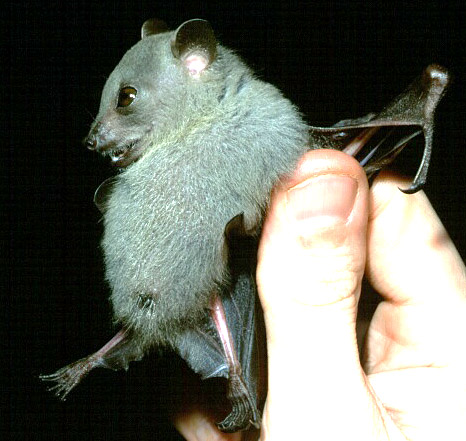Cynopterus brachyotis
Lesser Short-nosed Fruit Bat
Duan'er Quanfu
Morphological description Life history Distribution Habitat Roost sites and roosting patterns Emergence and flight pattern Foraging behaviour Echolocation calls Status and protection
Photo by Steve Rossiter
Morphological Description
· Paler in colour than C. sphinx, though fur colour varies from greyish to bright brown.
· Breeding adults may have orange on throat and shoulders.
· Fingers whitish in contrast to dark brown wing membranes.
· Forearm length 54-72 mm - smaller than C. sphinx on average. Ear length 13 - 18 mm, compare 18-21 mm in C. sphinx.
· Campbell et al. (2004; 2006) identified two cryptic taxa in the C. brachyotis lineage (Sunda and a smaller Forest type).Given this complexity, and that C. brachyotis and C. sphinx can easily be confused, the Chinese records are in need of reexamination.
Life history
· In other parts of range females are polyestrous and may produce a single youngster twice annually. Population density may reach 0.2-0.3 animals/hectare. Gestation 3.5-4 months, lactation 6-8 weeks (Smith & Xie 2008). Can live for 5 years in the wild, though potential longevity considerably greater than this.
Distribution
Wide ranging: found from Indian subcontinent through south Malayan region. In China known from Guangdong, though Wang (2003) also lists records from southern Yunnan and Xizang.
Habitat
· Habitats include secondary forest, agricultural areas and rural villages (Smith & Xie 2008)
Roost sites and roosting behaviour
· Diurnal roosts include the underside of the leaves but may also be found in cave entrances (Smith & Xie 2008).
· Emergence and flight pattern
· Can move 0.2 - 1.3 km (Smith and Xie 2008).
Foraging behaviour
· The diet consists of a large number of wild and cultivated fruits: also eats nectar and pollen (Smith & Xie 2008).
Echolocation calls
This species does not emit echolocation calls.
Status and protection
· There is no estimation of population size China.
· Short-nosed fruit bats are at LR/lc, assessed by the Red List of Threatened Species (IUCN, 2006). they are widely distributed and common in some areas of southern Asia. They are not listed in the Law of the People's Republic of China on the Protection of Wildlife in 1989. Status in China is RL-VU B1ab (i, ii, iii) (Smith & Xie 2008).
· It causes little damage to orchards. Probably important for seed dispersal. May be persecuted by fruit farmers.
· Possible threats may be habitat loss through development, dams, and deforestation, may also be hunted for medicinal purposes (IUCN, 2006).